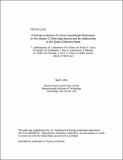External excitation of a short-wavelength fluctuation in the Alcator C-Mod edge plasma and its relationship to the quasi-coherent mode
Author(s)
Parker, R. R.; Davis, E.; Golfinopoulos, Theodore; Labombard, Brian; Burke, William M.; Granetz, Robert S.; Greenwald, Martin J.; Irby, James Henderson; Leccacorvi, Rick; Marmar, Earl S.; Parkin, William C.; Porkolab, Miklos; Terry, James L.; Vieira, Rui F.; Wolfe, Stephen M.; ... Show more Show less
DownloadPorkolab_External excitation.pdf (4.872Mb)
OPEN_ACCESS_POLICY
Open Access Policy
Creative Commons Attribution-Noncommercial-Share Alike
Terms of use
Metadata
Show full item recordAbstract
A novel “Shoelace” antenna has been used to inductively excite a short-wavelength edge fluctuation in a tokamak boundary layer for the first time. The principal design parameters, k[subscript ⊥] = 1.5 ± 0.1 cm[superscript −1] and 45 < f < 300 kHz, match the Quasi-Coherent Mode (QCM, k[subscript ⊥] ∼ 1.5 cm[superscript −1], f ∼ 50−150 kHz) in Alcator C-Mod, responsible for exhausting impurities in the steady-state, ELM-free Enhanced D[subscript α] H-mode. In H-mode, whether or not there is a QCM, the antenna drives coherent, field-aligned perturbations in density, [˜ over n][subscript e], and field, [˜ over B][subscript θ], which are guided by field lines, propagate in the electron diamagnetic drift direction, and exhibit a weakly damped (γ/ω[subscript 0] ∼ 5%−10%) resonance near the natural QCM frequency. This result is significant, offering the possibility that externally driven modes may be used to enhance particle transport. In L-mode, the antenna drives only a non-resonant [˜ over B][subscript θ] response. The facts that the driven mode has the same wave number and propagation direction as the QCM, and is resonant at the QCM frequency, suggest the antenna may couple to this mode, which we have shown elsewhere to be predominantly drift-mode-like [B. LaBombard et al., Phys. Plasmas 21, 056108 (2014)].
Date issued
2014-05Department
Massachusetts Institute of Technology. Department of Physics; Massachusetts Institute of Technology. Plasma Science and Fusion CenterJournal
Physics of Plasmas
Publisher
American Institute of Physics (AIP)
Citation
Golfinopoulos, T., B. LaBombard, R. R. Parker, W. Burke, E. Davis, R. Granetz, M. Greenwald, et al. “External Excitation of a Short-Wavelength Fluctuation in the Alcator C-Mod Edge Plasma and Its Relationship to the Quasi-Coherent Mode.” Phys. Plasmas 21, no. 5 (May 2014): 056111.
Version: Author's final manuscript
ISSN
1070-664X
1089-7674